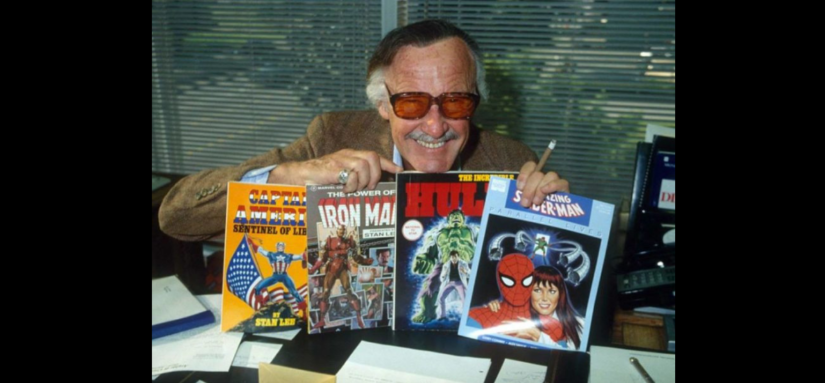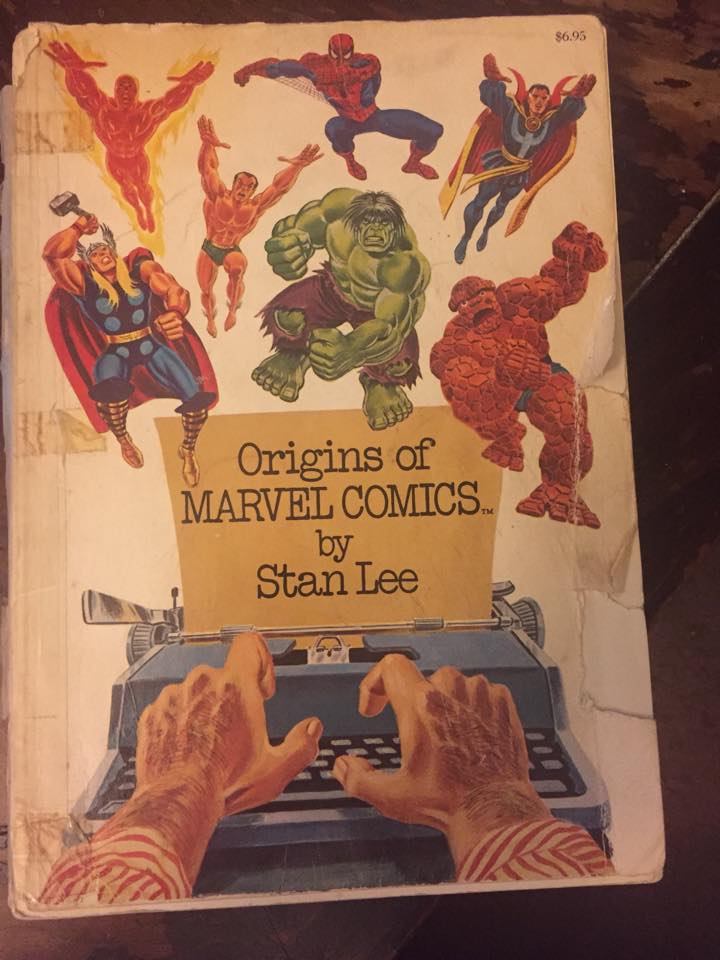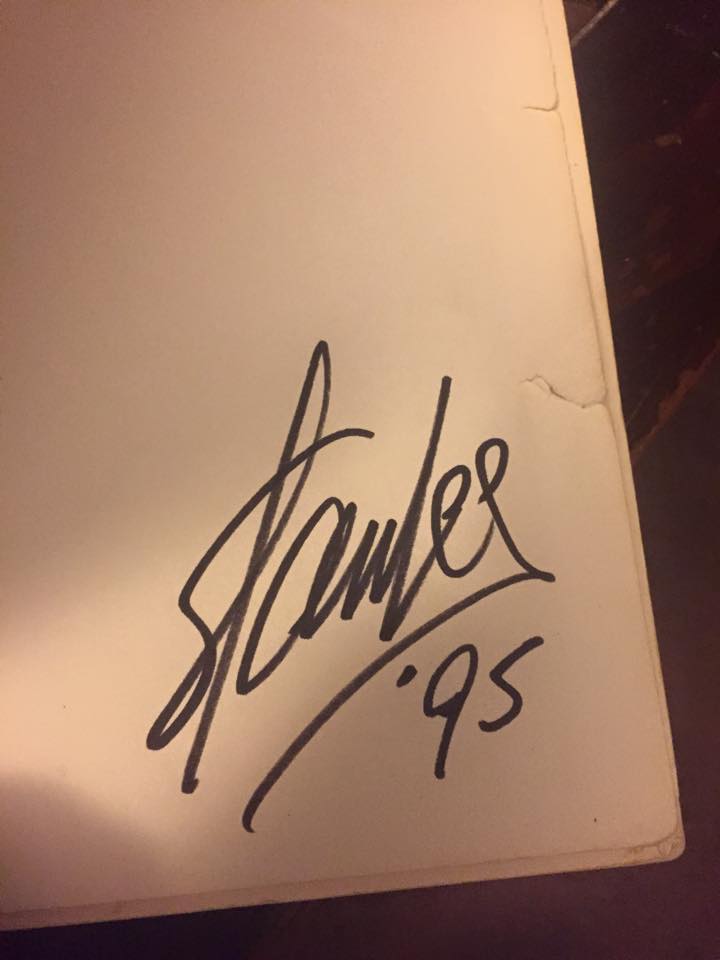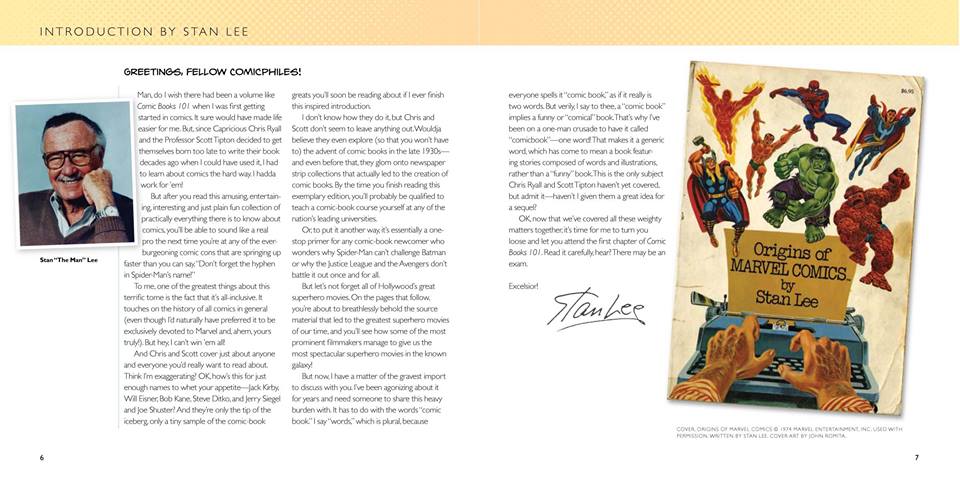It was 1995. I had just moved to Southern California after college and it was my first San Diego Comic-Con. And for the first time, I was in line to meet Stan Lee. Comic-Con wasn’t the total madhouse that it is today, so it was conceivable to just go to the Marvel booth, wait in a line, and have Stan Lee sign something for you. Which is exactly what I did.
I waited in the line, and watched as people carefully freed pristine comics out of mylar prisons, some exposed to the atmosphere for the first time in years, awaiting Stan’s sharpie benediction. I almost felt a little embarrassed, looking down at what I had brought: my beaten-up, dog-eared, Scotch-taped together copy of Origins of Marvel Comics, the first Marvel book I can remember reading; my parents gave it to me when I was three.
My turn at last, I stepped up to Stan’s table and rather sheepishly put my ragged book in front of him. “Would you mind signing this?” Stan’s eyes got wide behind his ever-present shades.
“Holy Cow!”
He snatched the book up and sprung to his feet, showing it to the people waiting in line behind me.
“Now this is the kind of book I love signing!” he shouted. “This is a book that somebody read! This is a book somebody loved.”
I told him how the book had led to a lifetime of loving comics, reading comics and thinking about comics, and an overall love of literature that delivered me to a college education and a career I was happy with (and this was 10 years before I began writing comics myself).
“Not bad for a seven-buck investment, right?” he cackled. I looked down to see the $6.95 price still visible on the beat-up cover.
“Not bad at all, Stan.”
And that was the day I first met Stan Lee.
I had one more notable encounter with Stan thirteen years later, but since my friend and Comic Books 101 co-author Chris Ryall has already told the story perfectly on social media, with your indulgence and his permission, I’ll give Mr. Ryall the floor:
***
In 2008, when Scott Tipton and I were finalizing our Comic Books 101 book, the writer who agreed to do the introduction for the book said at the last minute that it wasn’t going to happen. So what to do, what to do…
The guiding light for this book was Stan Lee. The reason we were drawn to comics as kids was Stan Lee. Was there any chance at all that Stan himself could be persuaded to do the intro? Nah, no way–we didn’t have much time until the print date, and Stan was certainly too busy. It’d be foolish to even ask.
I asked. He not only said yes, he wrote it that same day and emailed it to us a number of hours later.
Which, as much as anything else, epitomized who Stan was — a guy always willing to take the time to help proselytize for comics; to help out fans and creators; to leave everyone with a smile. We’re still smiling.
***
A couple additional thoughts on the above: Chris isn’t exaggerating about the time: We asked Stan if he’d consider writing it in late afternoon, and he had faxed over copy to us by midnight of the same day. And this was when he was 85.
And it’s bittersweet to look at our COMIC BOOKS 101 book now, with its introduction by Stan Lee and afterword essay by Harlan Ellison. The two biggest creative influences on my childhood, both gone in the same year. They say you should never meet your heroes, but every now and then, a precious few of us get lucky.
I could go on about how much Stan and his work meant to me forever, but instead I thought I’d present here a chapter from the aforementioned book Comic Books 101 by Chris Ryall and me, in which we take a closer look at Stan’s work, his influence and his impact.
***
If you’re looking for the most influential name in American comics, how can it not be Stan Lee? The Fantastic Four. The Hulk. Spider-Man. The Mighty Thor. Dr. Strange. The X-Men. Iron Man. The Avengers. As kids, thanks to the ORIGINS OF MARVEL COMICS reprint series, our first exposure to these characters wasn’t necessarily the comics currently being published, but their original appearances by Stan, Jack Kirby and Steve Ditko. Much is made of the fact that Kirby and Ditko don’t get enough credit for their work at Marvel, and there’s no denying that. However, it also always needs to be said that it was the voices of the characters that made Marvel’s heroes more alive than DC’s – the humor and angst of Spider-Man, the depression of Ben Grimm, the cool confidence of Captain America, the tortured soul of the Silver Surfer.
And even with the more than considerable partnership of fine artists and co-plotters like Kirby, Ditko, Gene Colan, John Romita, John Buscema and many others, it often goes unremarked that Stan was for quite a few years writing the bulk of Marvel’s output himself, not only balancing dozens of characterizations, but creating all of the countless connections that were woven back and forth between all the Marvel series, creating the notion of the “Marvel Universe” that DC and practically every other comic-book publisher would eventually imitate.
And on a personal level, it was reading Stan’s introductory chapters in the ORIGINS books that made us realize at a young age that there were people who actually made their living as writers, and that perhaps that might not be such a bad racket to get into.
So how to recommend the best Lee-penned stories? In looking at the hundreds of great comics in Lee’s long, storied career, this makes for a difficult if not unpleasant task. As always, it’s a matter of opinion. Is “The Green Goblin Unmasked” (AMAZING SPIDER-MAN 39-40) the best? Or “The Galactus Saga (FANTASTIC FOUR 48-50)? “The Return of Captain America”? (AVENGERS 4)? SILVER SURFER 4? It’s hard to say. The crowning glory of Lee’s initial output at Marvel—beyond the sheer inventiveness that he brought to all of the characters he helped create—is the 102 issues of FANTASTIC FOUR that he and Jack Kirby produced together. While later creators have surpassed the sheer number of consecutive issues created by a single team, the creativity, originality and sheer mastery of this centennial accomplishment will never be matched. And this is just one of the feats for which Lee is renowned. His long tenure on THE AMAZING SPIDER-MAN with Steve Ditko and then John Romita is equally as impressive, and the list only starts with these two titles.
Luckily, the bulk of Lee’s creative output is now readily available, both in handsome full-cover hardcovers and much more affordable ESSENTIAL black-and-white editions. The ambitious among you should start with FANTASTIC FOUR and AMAZING SPIDER-MAN and go forward from there.
Make Yours Marvel
Another feat for which Stan should be heralded is the sheer force of will he brought to bear in promoting the comics that Marvel produced. Beyond the act of creation and his scripting chores, Stan was (and is) a tireless, enthusiastic promoter of comics. Before Stan, comics were appreciated by fans for their colorful characters. Stan had the foresight to become a colorful character in his own right. He oversaw the letters pages, which allowed fans to have their say about a previous issue and receive bombastic replies from the folks creating these comics. Even his nicknames for himself and the creators in the credits boxes of Marvel’s comics (“Rascally” Roy Thomas, and so on) added to the sense of familiarity between creator and fan.
Stan further created “Stan Lee’s Soapbox,” a column in the letters pages where he talked up the comics in inimitable fashion. He talked about Marvel’s comics and fans’ support of them in conspiratorial fashion, making the readers feel like they were on the same team as the Marvel staff, all aligned in solidarity against the more staid “Distinguished Competition,” Stan’s gentle barb of a nickname for Marvel’s main competitor, DC Comics. He signed off his columns with “Excelsior!” because he liked the sound of it, but it was also one more call to arms that stuck in readers’ minds. While Stan was in charge, as far as he made fans feel, Marvel was the only place to be.
Stan talked up Marvel’s comics at cons. He made the rivalry with DC a personal, but never mean-spirited, thing. He oversaw the creation of Marvel fan clubs like the ‘60s M.M.M.S. (Merry Marvel Marching Society) and FOOM (a fan club/fan magazine) in the ‘70s.
Excelsior!
It was the development of Stan Lee as a public persona that led to his eventual positions as President, Publisher and finally Chairman Emeritus. In the early ‘80s, Stan headed West, moving to Southern California to function as Publisher from there while at the same time developing Marvel’s properties for Hollywood. Stan has been very active in helping develop Marvel’s characters as animated series, television shows and big-budget motion pictures. He also pursued other ventures outside of Marvel, creating new entertainment companies and developing all-new creations for print, the Web and for broadcast as well.
In 2001, Stan even crossed a line that longtime fans never thought they’d see—he wrote comics for the Distinguished Competition. JUST IMAGINE… STAN LEE CREATING THE DC UNIVERSE allowed Stan to pair up with acclaimed artists and take DC’s flagship characters and re-cast them in their own style. All of which was just one more way for Stan to do what he does best, keep finding new and exciting ways to create comic books and promote them to eager fans.
***
This was a difficult column to write, because I just never conceived of a world that wouldn’t have Stan Lee in it. But the saving grace is, there never will be a world that doesn’t have Stan Lee in it. His words, his ideas and his dreams changed so many of us forever, and have made millions of people happy for decades, and will continue to as long as people dream of adventure and look to the skies for heroes.
Excelsior, Stan. Excelsior.





Comments are closed.